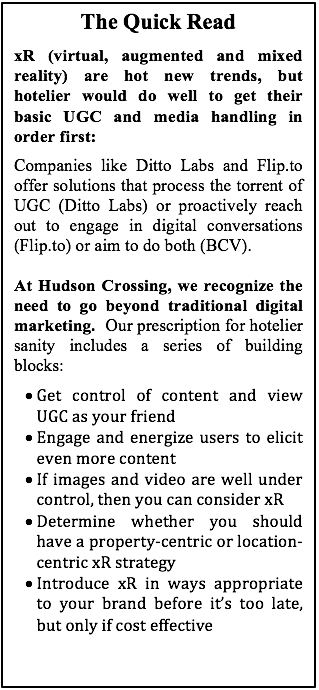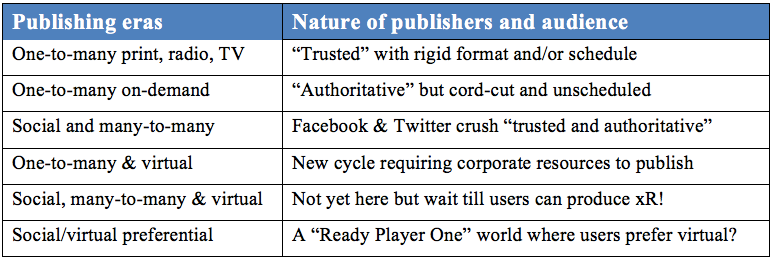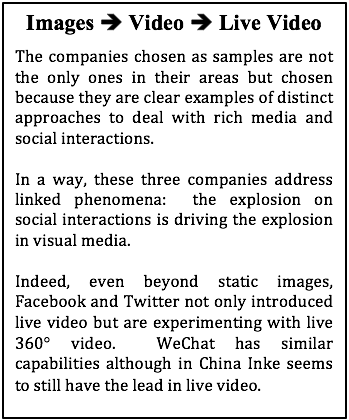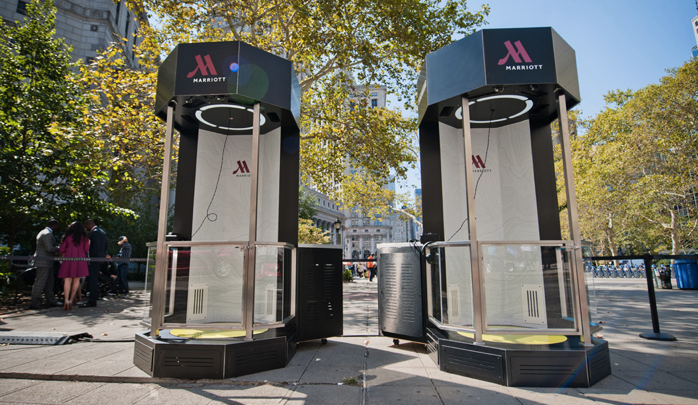 Back to Blogs
Back to Blogs
Emerging Media and xR Issues for Hotels
An explosion in visual content is already overwhelming, and soon we'll enter the xR “boss” level: voice I/O & virtual, augmented and mixed reality
In case you’ve been too busy to pay attention to the structure of video games, let me first say that “boss level” has nothing to do with higher floors where senior executive hang out in your chain’s headquarters.
“Boss level” or “boss battle” is the higher level of difficulty fight against a much tougher opponent which you can only reach in a video game after you’d overcome basic opponents and hurdles.

The analogy here is that hotels need to solve the basics of handling the issues around user generated content and UGC with images, then video and live content before confronting the challenges of virtual reality (VR), augmented reality (AR) and mixed reality (MR).
How we got into our current media and
x-Reality mess deserves fuller exploration before looking ahead
Ancient views on content assumed that people actually read text, which as I’ve discussed in an earlier post is wrong to start with (Content Creation Strategy – Mobile Takes It Beyond SEO). In most low-involvement situations, people don’t read more than seven words.
Still, those ancient views on the need to manage verbose content led to Content Management Systems (CMSs) which started out text-intensive and evolved to incorporate rich media. Gaps in CMS media handling features eventually led to ancillary systems such as Digital Asset Managers (DAMs).
These tools (CMSs, DAMs, etc.) fooled us into thinking we had digital content under control, but were plagued by two central fallacies:
- The assumption that the content that mattered most was the corporate generated content we wanted to push
- And the idea that persuasion is best achieved by overwhelming prospective guests with eye-chart tests and images rather than let guests dictate what’s emotionally satisfying to them
Those two fallacies (that corporate content mattered more than UGC and that words trump images) have direct implications for current problems most hoteliers are experiencing. But it may be good to take a step back and consider the nature of publishing from early days to now. Broadly speaking, authoritative “corporate” content was ignominiously defeated by Internet-scale UGC.

The nature of technology changed enough that things that used to be competitive advantages (such as the ability to publish and reach a mass audience or good content and a decent CMS) are now merely “hygiene factors” … that is they are required but no longer differentiating.
As users everywhere became creators, the volume of content started challenging traditional media companies, and most definitely overwhelming hoteliers. The solution here cannot be to hire an army of people to analyze and respond to social and micro-blog content… that is a losing battle.

It’s in this context that a mix of solutions have arisen to help hoteliers: some at the cutting edge of artificial intelligence (AI) and predominantly technology powered, others offering a mix more akin to social and content engagement service bureaus.

Ditto Labs: AI to The Rescue
David Rose, CEO of Ditto Labs and researcher at the MIT Media Lab recently asked this provocative question in his keynote address at HITEC, “3.2 billion photos are shared every day on social media. What do they say about your brand?” The honest answer for most is that we don’t know. Ditto Labs uses AI and computer vision to process every public photo on social media to provide an answer and allow you to take positive action.
As the world turns from corporate generated to user generated content, and not only that but also from verbose text to visual content, the sheer scale of Internet-wide UGC (so not just your guests but anybody else in the world reacting to anything one of your guests may have published) meant that people power alone would not cut it. In the case of Ditto Labs, they use AI to analyze context, location, identify brands and categorize sentiment.
Hoteliers may still introduce a final human review step before engaging or republishing content, but by the time it reaches your marketing team they no longer have to parse all of Twitter, Facebook, WeChat, etc. Your staff can just focus on the items that affect you and are flagged as deserving special attention.

BCV: Hybrid of Technology & Service Bureau
BCV is a hybrid, with technology driven analysis that is then backed up by human staff that engage prospective, current and former guests in social interactions 24/7.
As noted by Benji Greenberg, CEO of BCV, “We saw hoteliers had urgent needs in both positive and defensive engagement. BCV was created to enhance brand reputation and monetize social media for our clients, and we do this by capitalizing on opportunities and mitigating threats to brand reputation, as well as precision content targeting daily.” To which he added “Conversational AI is still early, it isn’t where it needs to be to engage with hotel guests, as recently demonstrated by the Microsoft AI bot that went haywire. We parse social data to boil it down to a relevant subset and then use highly trained communication specialists to engage each guest in the optimal way while further fine tuning our algorithms. The flood of content being shared about hotels on social is continuously increasing and hotels ability to simply ignore it and not operationalize it, simply won’t play in 2017 and beyond.”

Flip.to: Eliciting Rather Than Scanning Conversations
Flip.to takes another route that focuses on growing your hotel’s audience through advocacy. Rather than attempt to parse the “firehose” of data coming from social channels, it encourages known guests to share rich UGC about their stay across their entire travel journey. All content and its impact is tied back to a real person, and it’s easy to see real, trackable growth for your hotel.
Edward St. Onge, President of Flip.to noted “We offer hotels a way to let their guests tell a story that genuinely reflects their passion and experiences during their stay. Less the guest relationship and the impact, you’re left with only a photo. To grow your audience and see the impact of that growth, you need advocacy. Our data suggests that advocacy mixed with UGC is far more effective in generating demand than pay-per-click or property advertising.”
So, We Know There’s Help for Visual and Social UGC,
But That’s Here Today… What’s Around the Corner?
While images and video are going through the roof as part of a tidal wave of rich media UGC, technology has evolved enough that images and video creation has been “democratized”. These are well within reach of most guests, which is precisely why they are growing so fast.
Perhaps a little farther out, are high quality 360° video, and beyond that virtual reality, augmented reality and mixed reality which we’ll collectively refer to as xR.
Starting with 360° video, this can be done by done at an entry level by “prosumers” but can only be done truly well enough by professionals. Which explains why only brands with significant resources can afford to have it. For example, look at Madinat Jumeirah in Dubai, which provides comprehensive resort-wide 360° video.

While we might quibble with editorial choices that fail to tell an engaging story, the video richness and the attempt at merging xR with YouTube and back again are noteworthy. Then again Jumeirah makes a 24-carat gold iPad available to guests at Burj Al Arab, so resources are not scarce here.
Getting past 360° video, Marriott’s Teleporter, VR Postcards and Vroom Service are notable as xR experiments. Together, they take Travel Brilliantly from a marketing campaign to the edges of what it means to travel.

A few further definitions might be helpful at this point: what exactly are augmented reality, virtual reality and mixed reality?
- AR adds digital content (often informational or infomercial) on top of physical world environments. Users are where they are, and AR provides added info.
- VR immerse users in a mostly digital world. Visually, emotionally and by using extra dimensions such as smells and programmed physical motions VR helps users go where they aren’t.
- MR integrates a physical environment with virtual entities, and often uses mis-cues (such as slight misrepresentations of turns in a physical room) to allow a finite physical space to appear boundless. Not only that but it does so while preserving users’ ability to interact with both physical and virtual entities.
All of these become supercharged by developing capabilities in voice I/O and haptic feedback which enhance immersion by removing the need for cognitive dissonances such as having to move a mouse to interact with menus that might make a virtual world less credible.
However exciting, though, these are the areas where at the corporate level major chains have the resources to explore boundaries and start learning in ways that would not be cost effective for smaller players and most definitely not for independents. Hence our walk-before-running advice.
Yes there are exciting companies in xR, but no they are not ripe for most hoteliers yet. At this point the best approach for most hoteliers is to recognize that right now there’s more bang for the buck in optimizing image, video and social interactions than in xR.
Give it a few years though, and things may well change. One company alone, Magic Leap, has received over one billion dollars in investment capital. Meanwhile Facebook has hundreds of engineers focused on xR, as do other tech giants. xR is getting the kind of investor traction that presages major leaps forward. When those leaps occur and travel and hospitality xR solutions are around the corner, we’ll be previewing them here!
Published in print in Hospitality Upgrade’s Spring 2017 issue
 Previous Post
Previous Post